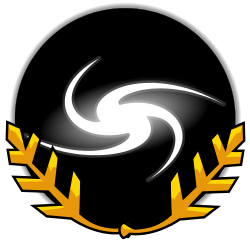Thousand Parsec
| Thousand Parsec | |
|---|---|
|
Thousand Parsec logo | |
| Developer(s) | Tim Ansell, Lee Begg |
| Platform(s) | Cross-platform |
| Genre(s) | 4X, Turn-based strategy |
| Mode(s) | single-player, multi-player |
Thousand Parsec (TP) is a free and open source project with the goal of creating a framework for turn-based space empire building games.
Thousand Parsec is a framework for creating a specific group of games, which are often called 4X games, from the main phases of gameplay that arise: eXplore, eXpand, eXploit and eXterminate.[1] Some examples of games from which Thousand Parsec draws ideas are Reach for the Stars, Stars!, VGA Planets, Master of Orion and Galactic Civilizations.
Unlike commercial alternatives, it is designed for long games supporting universes as large as the player's computer can handle. It allows a high degree of player customization, and features a flexible technology system, where new technologies may be introduced mid-game.
History
Development of the project (under a different name) was started in January 2002 by Tim Ansell.[2][3] Originally it was going to be a simple clone of Stars!. Later, Tim decided to try starting a full open source project to become the "Worldforge" of space empire games. He hoped that this would encourage other people who didn't want to just clone Stars! to help out with the project and give it a broader appeal. After the announcement of the project Lee Begg was the only person who joined it. Lee remained the only other major contributor until early 2007.[4]
By the year 2006 Thousand Parsec had not reached the envisioned goals. Partly the problem had been in the underestimation of the amount of work needed and partly because the project did not initially attract any new developers. Despite these setbacks, Thousand Parsec has a huge code base of framework; according to the Ohloh project stats, the project has produced 95,000 lines of code,[5] while Thousand Parsec's own code count puts it at 90,000.[6] The number of features left before full games of the complexity of Stars! can be produced is extremely small. According to the software analysis website Ohloh the project has had 47 individual contributors.[7]
Progress since late 2006 and early 2007 has been increasing rapidly[8] with a number of new developers joining the project. The project also went on a recruitment drive by running an AI programming competition [9] and active promotion during linux.conf.au.
In 2007 Thousand Parsec was allocated 3 slots in the 2007 Google Summer of Code.[10]
In 2008 Thousand Parsec was fortunate enough to be allocated 8 slots for Google Summer of Code.[11] Projects include three new rulesets, a 3D client, three AI-related projects, and a project to extend the server and create a single-player mode.
In 2009 Thousand Parsec again participated in the Google Summer of Code, being given 7 slots.[12]
Thousand Parsec has had significant success in developing students into full-fledged contributors;
Local developer Eugene Tan, who last year contributed code to the Thousand Parsec project--an open source framework computer game--was invited by the project's lead developer to mentor this year's participants for the project. Tan told ZDNet Asia: "Returning as a mentor is important to me because this is in keeping with the spirit of the open source community, where I am sharing my knowledge and contributing my expertise to collaborate with other programmers to develop better, more innovative applications."
References
- ↑ "About Thousand Parsec". 2008-03-17.
- ↑ "Thousand Parsec goals and direction". 2006-01-02. Retrieved 2006-11-21.
- ↑ "itwire: linux.conf.au: Games Linux users play".
- ↑ "Ohloh Project Stats, Thousand Parsec, Contributors". Archived from the original on 2007-09-28. Retrieved 2007-05-27.
- ↑ "Ohloh Project Stats, Thousand Parsec, Project Cost". Retrieved 2007-05-27.
- ↑ "Thousand Parsec : Lines of Code". Retrieved 2007-05-27.
- ↑ "Ohloh Project Stats, Thousand Parsec Contributors".
- ↑ "Ohloh Project Stats, Thousand Parsec, Code". Retrieved 2007-05-27.
- ↑ "Thousand Parsec: News - Thousand Parsec AI Programming Competition!". 2007-01-16.
- ↑ "Thousand Parsec: News - Google Summer of Code Allocations". 2007-04-14. Retrieved 2007-05-11.
- ↑ "Thousand Parsec: News - Meet Thousand Parsec GSoC 2008 Students". 2008-04-23. Retrieved 2008-05-04.
- ↑ "Google Summer of Code project list for Thousand Parsec".
- ↑ "zdnet Asia: Google taps student developers for OSS".
External links
- The official home page of Thousand Parsec project
- Thousand Parsec Wiki
- Thousand Parsec chapter from The Architecture of Open Source Applications book
